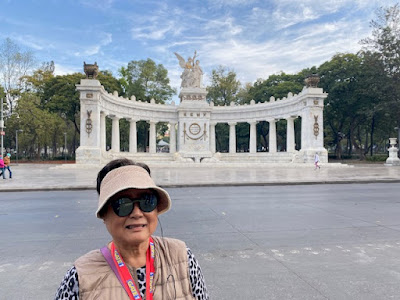After we stayed in Mazatlan for three weeks, we took a flight to go to Mexico City on December 16. We stayed in this mega city for a week until Gate 1's Colonial Mexico tour began on December 23. Mexico City is one of the largest cities in the world with a population of 23 million. There are three "Mexicos." They are the country Mexico, the Mexico City, and the State of Mexico. The country Mexico's full name is the United Mexico States. The Mexico City is the Ciudad de Mexico or CDMX. The State of Mexico is close to CDMX but is mutually different.
Mexico is a big country with 31 states and CDMX. We have visited many places before, but this time we wanted to take Gate 1 Tour to visit the colonial places of Central Mexico, starting at CDMX, visiting Teotihuacan, Queretaro, San Miguel de Allende, Guanajuato, Morelia, and ending in Guadalajara.
Our journey in Mexico City had to be broken into several parts because it is too much to cover in one blog post. This post covers the landmarks in CDMX.
Bosque de Chapultepec is a huge park that is twice as big as New York's Central Park. Chapultepec means "on the hill of grasshopper" in the Nahuatl language. So there are signs of a grasshopper all throughout the park. The park has several museums, a castle, a few lakes, a stadium, and several gardens.
At the center of the park is a castle, called The Castle of Chapultepec. It was once used as the residence of Spaniad's governor. It is now used as the National Museum of History.
The park has three sections and it would take a whole day to look around the entire area. I walked around section 1 where the Castle is located and a lake where people were doing water sports. The second section is for sports activities and the third section is for a garden and a forest.
 |
| Mexico has this emblem of an eagle holding a snake on top of cactus |
Mercado de San Juan is one of several markets in Mexico City. This one was the closest to the hotel we stayed and it was quite small in scale. Nonetheless, it is fun to walk around the market all the time. There were a few gross scenes, including baby pigs, and a display of bugs and insects, including scorpions, to be put into tequila. No thanks!
Palacio de Bellas Artes means Fine Arts Palace. It is now used as an opera house. It is a beautiful building located right next to Alameda Central.
Zocalo is located at the center of a city in Mexico. It is a big plaza in line with the town or city's size. Obviously, CDMX has a huge zocalo. It is surrounded by important buildings such as the National Palace and the Cathedral.
 |
| National Art Museum |
 |
| National Palace |
Torre Caballito is a modern art sculpture located close to the hotel we stayed: Barcelo Reforma Mexico. It stands out with a bright yellow color in the surroundings.
Alameda Central Park and Centro The downtown of CDMX is called Centro. In the area are a lot of shops and restaurants, plus important and interesting buildings and structures. Among them was a Chinatown.
Transportation - I explored the city with public transportation. I secured a card, recharged it at the bus station, and used it for metro buses and metro subways. The subway was far too crowded because it was a bit cheaper (5 pesos) than the metro bus (6 pesos).
We also rode two lines of Hop-on Hop-off buses run by Capital Bus.
















.jpg)










































No comments:
Post a Comment